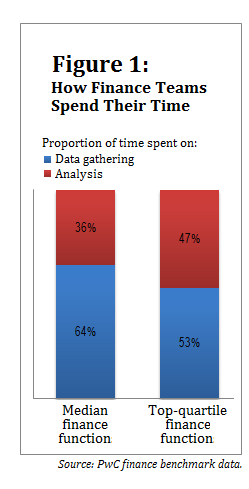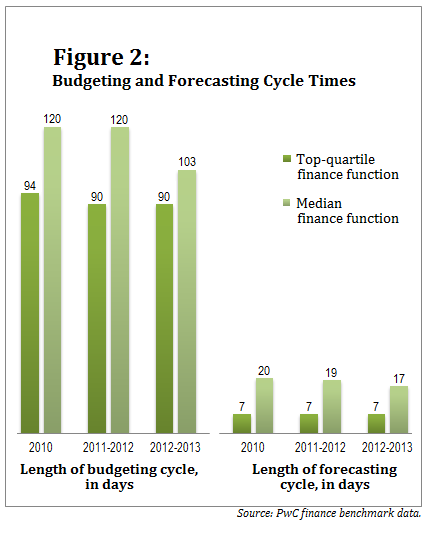In its recent report “Unlocking Potential: Finance effectiveness benchmark study 2013,” PwC benchmarked the finance functions of more than 200 companies based on their performance in everything from the quality of their budgets and financial forecasts to the efficiency of their transactional processes to their effectiveness in treasury, risk management, tax compliance, and audit. Then it grouped the finance teams into quartiles and compared them across a variety of characteristics.
In terms of efficiency, the survey found that the cost of finance for top-quartile businesses is 0.56 percent of corporate revenue. For the median company, that number is 0.93 percent—so the proportion of corporate revenue that goes toward finance costs is nearly two-thirds higher for the typical finance function than for top teams.
Moreover, leading finance functions are using their slice of the budget to do a lot more analysis. In the median company, the finance team spends nearly two-thirds of their time on data gathering and just over one-third on analysis. For top-quartile finance teams, that ratio is much closer to 50:50 (see Figure 1).
Performance management is one area that seems to drag down the typical finance organization. Budgeting and forecasting processes are becoming more efficient for the median company, but they continue to lag significantly behind those of top-quartile businesses (see Figure 2, below). Nearly half of respondents said their financial reporting processes still involve manual manipulation of spreadsheet data, and 72 percent said their company does not have a single database for financial reporting. Perhaps that explains why survey respondents ranked technology improvements as the top method for improving the effectiveness of finance processes.
At the same time they continue to boost the efficiency of their day-to-day operations, many finance organizations are taking on a more strategic role in the company. Forty-two percent of survey respondents see finance as a facilitator in the strategic planning process, rather than playing only a supporting role, and 53 percent see finance working closely with the CEO in developing the company's business strategy.
“The C-suite and business-line leaders are increasingly asking for their finance organization to play a higher strategic role in the company's overall business plan, evaluating and recommending changes to business models and seeking innovative ways to improve profitability,” says Carol Sawdye, U.S. vice chairman and CFO of PwC.

© 2025 ALM Global, LLC, All Rights Reserved. Request academic re-use from www.copyright.com. All other uses, submit a request to [email protected]. For more information visit Asset & Logo Licensing.




